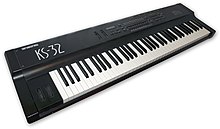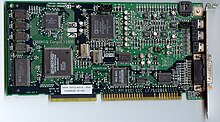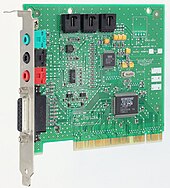Ensoniq
This article includes a list of generalreferences,butit lacks sufficient correspondinginline citations.(April 2009) |
| Company type | Subsidiary |
|---|---|
| Industry | Musical instruments and technology |
| Founded | 1982 |
| Defunct | 2002 |
| Fate | Acquired byCreative Technology(January 1998) and merged withE-MU Systems,now dissolved |
| Headquarters | Malvern, Pennsylvania |
Key people | Bruce Crockett, Al Charpentier, andBob Yannes(founders) |
| Parent | Creative Technology |
| Website | www.ensoniq.comat theWayback Machine(archived July 19, 1997) |
Ensoniq Corp.was an Americanelectronicsmanufacturer, best known throughout the mid-1980s and 1990s for itsmusical instruments,principallysamplersandsynthesizers.
History
[edit]In spring 1983, formerMOS TechnologyengineersRobert "Bob" Yannes,Bruce Crockett,Charles Winterble, David Ziembicki, andAl CharpentierformedPeripheral Visions.The team had designed theCommodore 64,and hoped to build another computer. To raise funds, Peripheral Visions agreed to build a computer keyboard for theAtari 2600,but thevideo game crash of 1983canceled the project and Commodore sued the new company, claiming that it owned the keyboard project. Renaming itself as Ensoniq, the new company instead designed a music synthesizer.[1]
Ensoniq grew rapidly over the next few years with the success of the Mirage and the ESQ-1. The plant in Great Valley, Pennsylvania employed nearly 200 people and housed the manufacturing facility. A number of successful products followed which all included the full-customICsfor music and effects which were developed in house. While the core keyboard products were generally successful, there were some quality problems and increasing competition from Asian companies. An attempt to diversify into hearing aids was unsuccessful and put the company in financial peril. In the mid-nineties, they developed a line of very cost-effectivesound cardswhich sold millions of units.
In January 1998, ENSONIQ Corp. was acquired byCreative TechnologyLtd. for $77 million. The acquisition was focused on the sound-card technology of the Ensoniq Audio-PCI. The musical products division, which was in financial trouble, was merged withE-mu Systemsto form the E-Mu/Ensoniq division of Creative. Over the next three years the Ensoniq operation in Pennsylvania was gradually dismantled and shut down. After releasing an entry-level E-mu MK6/PK6 and Ensoniq Halo keyboards in 2002 – essentially keyboard versions of the Proteus 2500 module – the E-Mu/Ensoniq division was dissolved and support for legacy products was discontinued soon afterward.[2]
Musical instruments and digital systems
[edit]

Ensoniq entered the instrument market with theMiragesampling keyboard in 1985. At the price ofUSD$1695 it cost significantly less than previoussamplerssuch as theFairlight CMIand theE-MU Emulator.Starting with theESQ-1,they began producingsample-based synthesizers.Following the success of these products, Ensoniq established a subsidiary inJapanin 1987.
Ensoniq products were highly professional. Strong selling points were ease-of-use and their characteristic "fat", rich sound (generally thought of as being an "American" quality, as opposed to the "Japanese" sound which was more "digital" and somewhat "cold" ). After the Mirage, all Ensoniq instruments featured integrated sequencers (even their late '80s and early '90ssamplers) providing an all-in-one "digital studio production concept" instrument. These were often called "Music Workstations". Starting with the VFX synthesizer, high-quality effects units were included, in addition most synthesizer and all sampler models featureddisk drivesand/orRAMcards for storage. The manuals and tutorial documents were clearly written and highly musician-oriented, allowing the users to quickly get satisfactory results from their machines. In 1988, the company enlisted theDixie Dregsin a limited edition promotional CDOff the Recordwhich featured the band using the EPS sampler and SQ-80 cross wave synthesizer.
The company had much success with the SQ product line starting in the early 1990s. This was a lower-cost line that included the SQ-1 (61 keys), SQ-2 (76 keys) and SQ-R (rack-mounted,with no keys or sequencer), as well as KS-32 with full 76-keys weighted piano-keyboard. Later versions were produced with 32 sound-generating voices.


The company's heyday was in the early 1990s when the VFX synthesizers offered innovative performance and sequencing features (and terrific acoustic sounds), along with the ASR series of 16-bit samplers which also integrated synthesis, effects, and sequencer into a single-unit digital studio. The TS synthesizers followed the legacy of the VFX line, improving several aspects such as thepolyphony,effects engine, sample-loading capabilities and even better synth and acoustic sounds. The DP series of effects rack-mount units offered parallel processing andreverbpresets on a par with Lexicon's offerings, but at affordable prices.

Despite these strengths, early (1980s) Ensoniq instruments suffered from reliability and quality problems such as bad keyboards (Mirage DSK-8), under-developed power-supply units (early ESQ-1), or mechanical issues (EPS polypressure keyboard). Through the early and mid-1990s, much effort was focused on improving the reliability of the products. The company did not manage to reinvent its workstation concept in order to survive the mid and late '90s.
Timeline of major products
[edit]



- 1984 –Ensoniq Pro-Cussion
- 1985 –Ensoniq Mirage
- 1986 –Ensoniq ESQ-1
- 1986 –Ensoniq SDP-1 Sampled Digital Piano[3]
- 1988 –Ensoniq SQ-80
- 1988 –Ensoniq EPS
- 1989 – Ensoniq EPS-M[4]
- 1989 –Ensoniq VFX
- 1989 –Ensoniq VFX-SD
- 1990 – Ensoniq SQ-1[5]
- 1990 – Ensoniq SQ-R
- 1990 –Ensoniq EPS 16 Plus
- 1990 –Ensoniq SD-1
- 1991 – Ensoniq SQ-R+
- 1991 – Ensoniq SQ-1+
- 1991 – Ensoniq SQ-2
- 1992 – Ensoniq SQ-1+ 32 voice
- 1992 – Ensoniq SQ-2 32 voice
- 1992 – Ensoniq SQ-R+ 32-voice
- 1992 –Ensoniq KS-32

- 1992 –Ensoniq ASR-10
- 1992 –Ensoniq TS-10and TS-12
- 1993 –Ensoniq DP/4[6]
- 1994 – Ensoniq KT-76 and Ensoniq KT-88
- 1995 – Ensoniq DP/2[7]
- 1995 – Ensoniq DP/4+
- 1996 –Ensoniq MR61
- 1997 –Ensoniq ASR X[8]
- 1997 – Ensoniq DP/Pro
- 1997 –Ensoniq E Prime

- 1998 –Ensoniq Fizmo
- 1998 –Ensoniq ZR-76
- 1998 –Ensoniq ASR X Pro
- 1998 –Ensoniq PARIS Digital Audio Workstation[9]
- 2002 –Ensoniq Halo(E-mu product using Ensoniq brand)
Sound cards and semiconductors
[edit]In 1986, after making an agreement withApple Computer,the sameES5503 DOC(Digital Oscillator Chip, marketed as "Q-Chip" ) used in the Mirage sampler (DSK-8, DSK-1, DMS-1), ESQ-1, ESQ-M and SQ-80 synthesizers, and SDP-1 piano module, was incorporated into theApple IIGSpersonal computer.
Later engines, with 16-bit sample playback and internal digital filters, were ES5504 DOC-II (used in the EPS sampler) and ES5505 OTIS (used in the EPS16+ sampler and the VFX line of synthesizers featuring 21 voices). Finally,ES5506 OTTOdrove all subsequent 32-voice machines (SD-1/32, TS10/12, ASR-10/88) and the dual-OTTO machines (KT, MR, ZR). The latest incarnation, ES5548 OTTO-48, was used in the final line of Ensoniq studio products (ASR-X, FIZMO).
Ensoniq also developed an effects DSP, ES5510 ESP, that was used in the machines from VFX on and the standalone FX units DP/2 and DP/4. OTTO-48 generation uses its greatly enhanced successor, ES5511 ESP V2. A combination of OTTO and ESP, ES5540 OTTOFX, was also developed and sold.
The Ensoniq ES5505 OTIS/OTISR2, and ES5510 ESP (Ensoniq Signal Processor) were also used in variousarcade games.They were all manufactured on theCMOSprocess. OTTO was licensed toAdvanced Gravisfor use in theGravis Ultrasoundcard. In 1994, production began onPCsound cards for home computers. The design of the video-game consoleAtari Pantheralso included the OTIS chip, though the product never reached series production. A dedicated version of OTTO, ES5530/35 OPUS, was developed for AT-bus sound cards, featuring built-in joystick and CD-ROM interface.
Ensoniq's sound cards were popular and shipped with manyIBM PC compatibles.Many games in the lateMS-DOSera supported the Ensoniq Soundscape either directly or throughGeneral MIDI.In addition, Ensoniq devised anISAsoftware audio emulation solution for their newPCIsound cards that was compatible with most contemporary IBM PC games. It is speculated that this was an important factor inCreative Lab'sacquisition of Ensoniq, because Creative/E-MU was struggling with legacy compatibility at the time with their higher-performance PCI audio solutions.
Soundscape
[edit]

- Ensoniq Soundscape S-2000The original Soundscape was Ensoniq's first direct foray into the PCsound cardmarket. It was a full-length ISA digital audio and 'wavetable'sample-based synthesisaudio card, equipped with a 2 MB Ensoniq-builtROM-based patch set.
- Ensoniq SoundscapeDBThe SSDB was a 'wavetable'daughterboard(sample-based synthesisdaughterboard) upgrade for PCs with a sound card bearing aWave Blaster-compatible connector. It was based upon the S-2000 chipset but was without the digital sound effects section or anyDAC.The SSDB would use the host sound card for final output.

- Ensoniq Soundscape Elitewas Ensoniq's high-end ISA offering. It offered the highest MIDI quality of any PC sound card they ever made, including the newer AudioPCI. The Elite was based mostly around the S-2000, with some additional features that set it far apart from its progenitor.

- Ensoniq Soundscape OPUSThis card was aGateway 2000OEM,and possibly was used by other OEMs, but was never sold to Ensoniq's customers directly. It was a Soundscape-like board, using the Ensoniq 5530/5535 OPUS multimedia sound chip, a chip that was only used on these OEM boards and essentially comprises an OTTO with back-then usual additional interfacing (Joystick, CD-ROM).
- Ensoniq Soundscape VIVO90 was Ensoniq's generational step forward from the Ensoniq Soundscape S-2000-based boards. It was first produced in 1996. VIVO90 had similar specifications to the older boards, but was built to cost less to manufacture.
AudioPCI
[edit]
- Ensoniq AudioPCIThe AudioPCI was designed to be a low-cost, yet feature-rich audio solution, which could be integrated on computer motherboards as a value-added option. It consisted of little more than a small, host CPU driven audio chip (one of the following: S5016, ES1370, ES1371) and a companionDAC.Despite its small size and low cost, AudioPCI still offers nearly all of the audio capabilities and functionality of the Soundscape ELITE card. The AudioPCI line used anNMI-based emulationterminate-and-stay-resident(TSR) program Ensoniq developed to provide a reasonable level of legacy DOS compatibility without requiring any signals from the ISA bus, though the TSR could cause problems with games that relied on custom flavors ofprotected mode.
References
[edit]- ^Perry, Tekla S.; Wallich, Paul (March 1985)."Design case history: the Commodore 64".IEEE Spectrum.22(3): 48–58.doi:10.1109/MSPEC.1985.6370590.ISSN0018-9235.Retrieved2011-11-12.
- ^"The Amazing Ensoniq".Keyboard Kountry.Retrieved2021-10-03.
- ^"Ensoniq Sampled Piano".Sound On Sound.September 1986. pp. 8–9.ISSN0951-6816.OCLC925234032.
- ^"Ensoniq EPS-M Sampler Module".Music Technology.May 1989. p. 14.ISSN0957-6606.OCLC483899345.
- ^"Ensoniq SQ1".Music Technology.October 1990. pp. 64–69.ISSN0957-6606.OCLC483899345.
- ^"Parallel Lines".Recording Musician.August 1992. pp. 32–36.ISSN0966-484X.OCLC264952514.
- ^"Ensoniq DP/2".Sound On Sound.December 1995. Archived fromthe originalon 8 June 2015.
- ^"Ensoniq ASRX".Sound On Sound.September 1997. Archived fromthe originalon 7 June 2015.
- ^"Ensoniq Paris II".Sound On Sound.January 1998. Archived fromthe originalon 24 September 2015.
- Ensoniq Corp., Dixie Dregs, "Off the Record", ENS-1000, 1988.
- Case, Loyd. "In Search Of The Ultimate... Sound Card." Computer Gaming World Dec. 1994: 138-148.
- Ensoniq Corp. Soundscape S-2000 Manual, Ensoniq, 1994.
- "Ensoniq Corp. Web Site"by Ensoniq Corp., Multimedia Division Product Information and Support Pages, 1998, retrieved December 25, 2005
- "Ensoniq FAQ"by Ensoniq Corp., Multimedia Division Product Information and Support Pages, 1997, retrieved December 27, 2005
- Prince, Bobby. "In Search Of The Ultimate... Wavetable Daughtercard." Computer Gaming World Dec. 1994: 156-164.
- Weksler, Mike & McGee, Joe. "CGW Sound Card Survey." Computer Gaming World Oct. 1993: 76-84.

